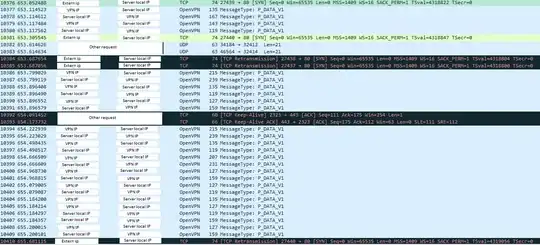I am searching for a solution to route all traffic from a server through OpenVPN but keep it possible to host applications on the server which can be accessed outside of the local area network.
To be a little more specific: There are two applications hosted on the server. There is one application that binds port 80 and one that binds port 8080. All traffic to and from these services have to go direct, all other traffic has to go through the VPN tunnel.
At the moment, requests are being received directly but not answered when the VPN is running. All services can be reached when I disable the VPN:
How can I configure OpenVPN, for example with an up script, so that these routes will be routed correctly?
An overview of my network interfaces:
lo Link encap:Local Loopback
inet addr:127.0.0.1 Mask:255.0.0.0
inet6 addr: ::1/128 Scope:Host
UP LOOPBACK RUNNING MTU:65536 Metric:1
RX packets:537169 errors:0 dropped:0 overruns:0 frame:0
TX packets:537169 errors:0 dropped:0 overruns:0 carrier:0
collisions:0 txqueuelen:0
RX bytes:147901148 (147.9 MB) TX bytes:147901148 (147.9 MB)
p4p1 Link encap:Ethernet HWaddr xx:xx:xx:xx:xx:xx
inet addr:192.168.2.201 Bcast:192.168.2.255 Mask:255.255.255.0
inet6 addr: xxx/64 Scope:Global
inet6 addr: xxx/64 Scope:Link
UP BROADCAST RUNNING MULTICAST MTU:1500 Metric:1
RX packets:8062700 errors:0 dropped:180 overruns:0 frame:0
TX packets:10937639 errors:0 dropped:0 overruns:0 carrier:0
collisions:0 txqueuelen:1000
RX bytes:7942028079 (7.9 GB) TX bytes:12229412785 (12.2 GB)
tun0 Link encap:UNSPEC HWaddr 00-00-00-00-00-00-00-00-00-00-00-00-00-00-00-00
inet addr:XX P-t-P:XX Mask:255.255.255.255
UP POINTOPOINT RUNNING NOARP MULTICAST MTU:1500 Metric:1
RX packets:6382168 errors:0 dropped:0 overruns:0 frame:0
TX packets:6004894 errors:0 dropped:46397 overruns:0 carrier:0
collisions:0 txqueuelen:100
RX bytes:7066816609 (7.0 GB) TX bytes:4808493953 (4.8 GB)
Routing tables before connection with the VPN:
ip route show
default via 192.168.2.254 dev p4p1
192.168.2.0/24 dev p4p1 proto kernel scope link src 192.168.2.201
Routing tables after connection with the VPN:
ip route show
0.0.0.0/1 via 10.124.1.5 dev tun0
default via 192.168.2.254 dev p4p1
10.124.1.1 via 10.124.1.5 dev tun0
10.124.1.5 dev tun0 proto kernel scope link src 10.124.1.6
109.201.154.152 via 192.168.2.254 dev p4p1
128.0.0.0/1 via 10.124.1.5 dev tun0
192.168.2.0/24 dev p4p1 proto kernel scope link src 192.168.2.201

